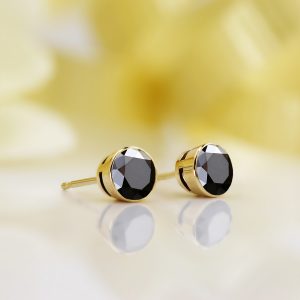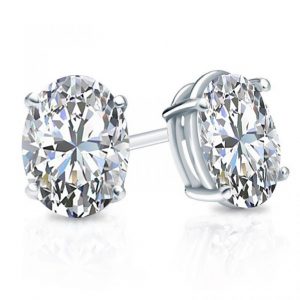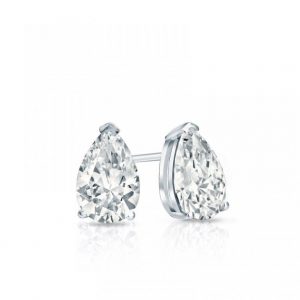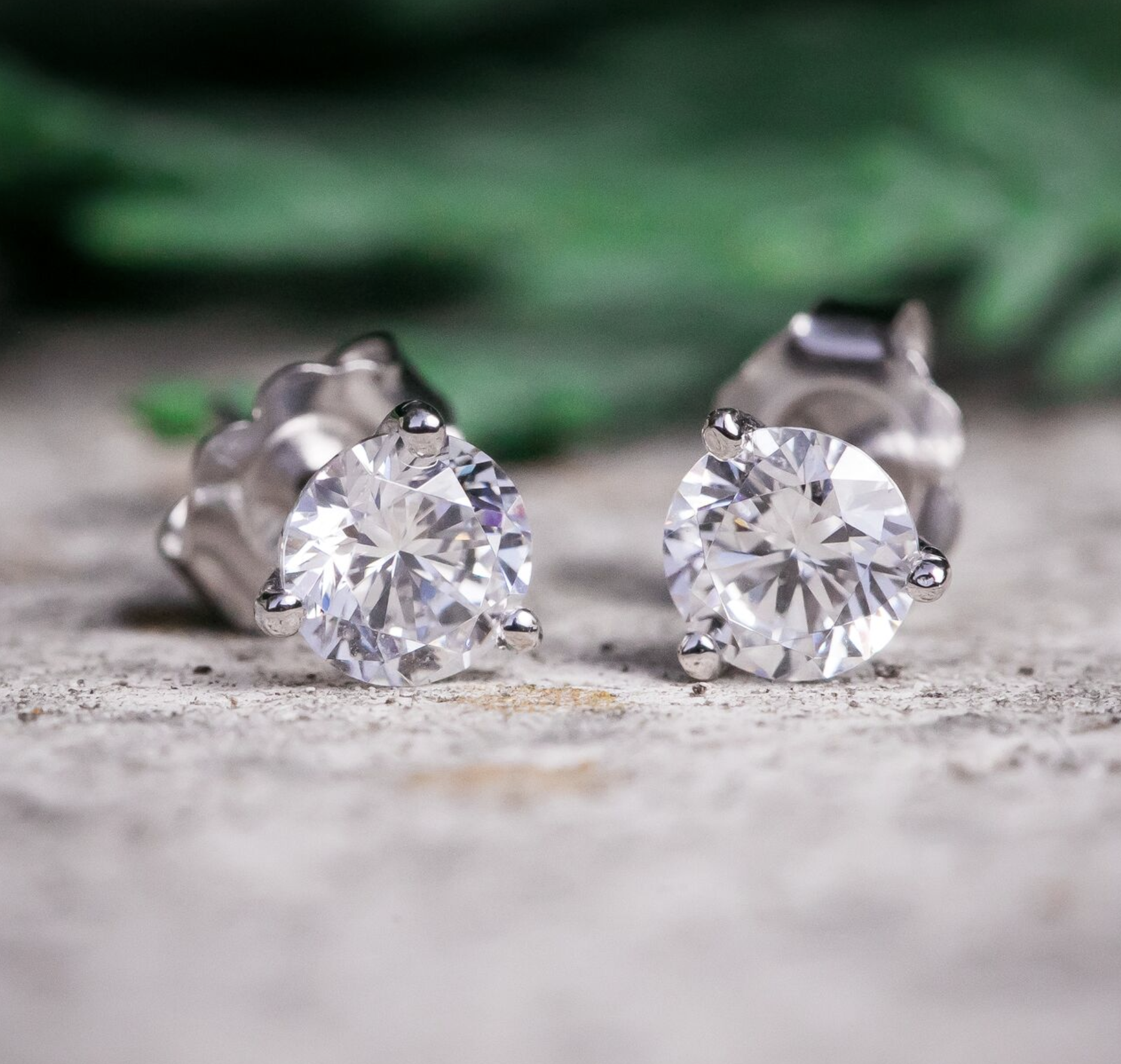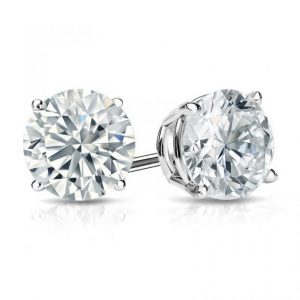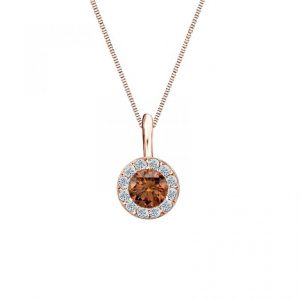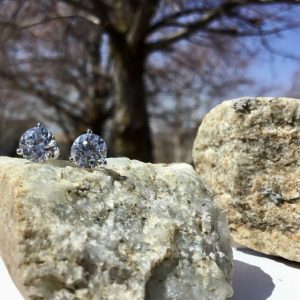In Part One of our guide to finding the best setting for your diamond studs, we provided an overview of the aesthetics of the three most popular stud earring styles to help you find your ideal style fit. In Part Two, we’ll be getting a bit more in depth with our guide to finding your perfect earring settings, as we go over all the finer details of the setting selection process step-by-step. We’ll start our step-by-step guide with a refresher on your setting style options, then we’ll go over your precious metal options and talk more about the pros and cons of the different types of earring backs you can choose from for your diamond studs.
Step One: Selecting Your Setting Style
The first thing you should decide on when picking out your diamond stud earring settings is your setting style. Your choice of setting style has the biggest impact on the overall style of your studs, and it can also impact how well-suited your studs are to your lifestyle.
Prong Settings
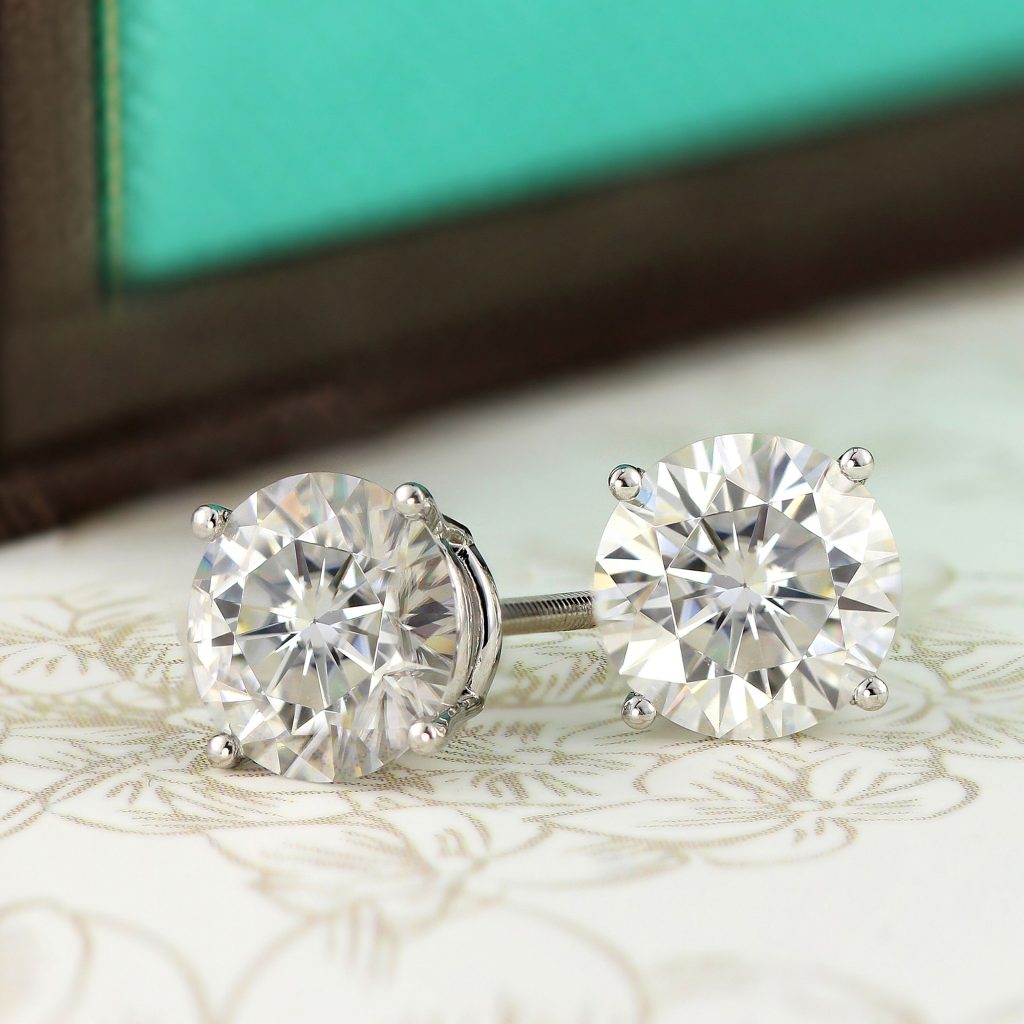
These round diamond studs feature classic 4-prong basket style settings.
Prong settings are the most popular setting style option for diamond stud earrings. This type of setting holds your diamonds in place with prongs, which are tiny pieces of metal. This setting style is loved because it has an elegant, classic style. Then, it’s also loved because it allows for excellent light entry, which makes your center diamonds shimmer to maximum effect.
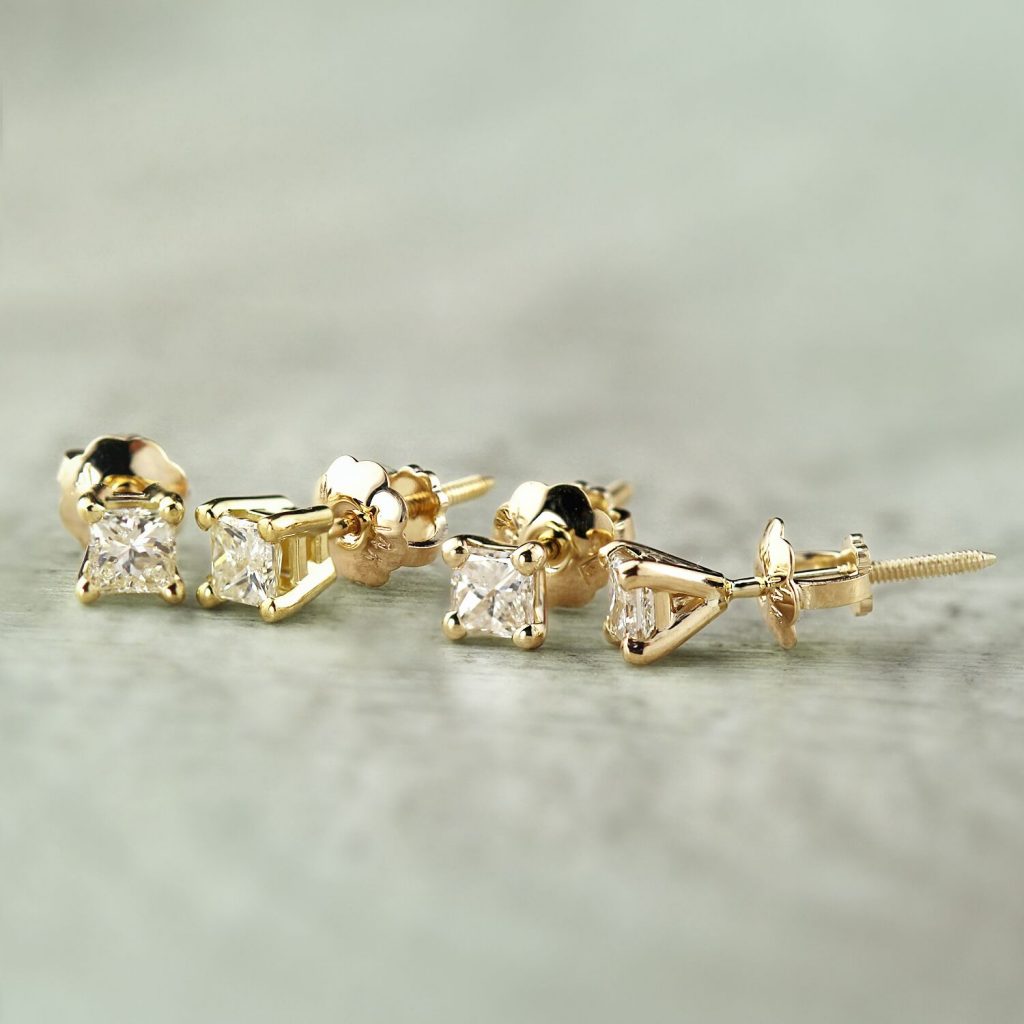
The solitaire princess cut diamond studs on the left feature the 4-prong basket setting style, while the studs on the right feature the 4-prong martini style setting.
Prong settings can feature any number of prongs, but they usually come in one of three styles: the 4-prong basket style, the 4-prong martini style, or the 3-prong martini style. 4-prong basket settings are the more popular of these three pronged styles, since they have the most traditional and classic look. Then, 4-prong and 3-prong martini settings, named for their resemblance to a martini glass, are still quite popular, but offer a more streamlined and modern look.
Bezel Settings
Bezel settings have two main advantages: their decidedly modern style and their excellent protection. This style of stud setting, typically only used for round diamonds, holds your center diamonds in place by enclosing them in a ring of metal. This ring of metal provides superior protection for diamonds and other gemstones, which can make a bezel setting a good choice for someone with a more active lifestyle. Then, bezel settings look quite sleek, which makes them a good option for anyone who loves their chic, contemporary style.
Halo Settings
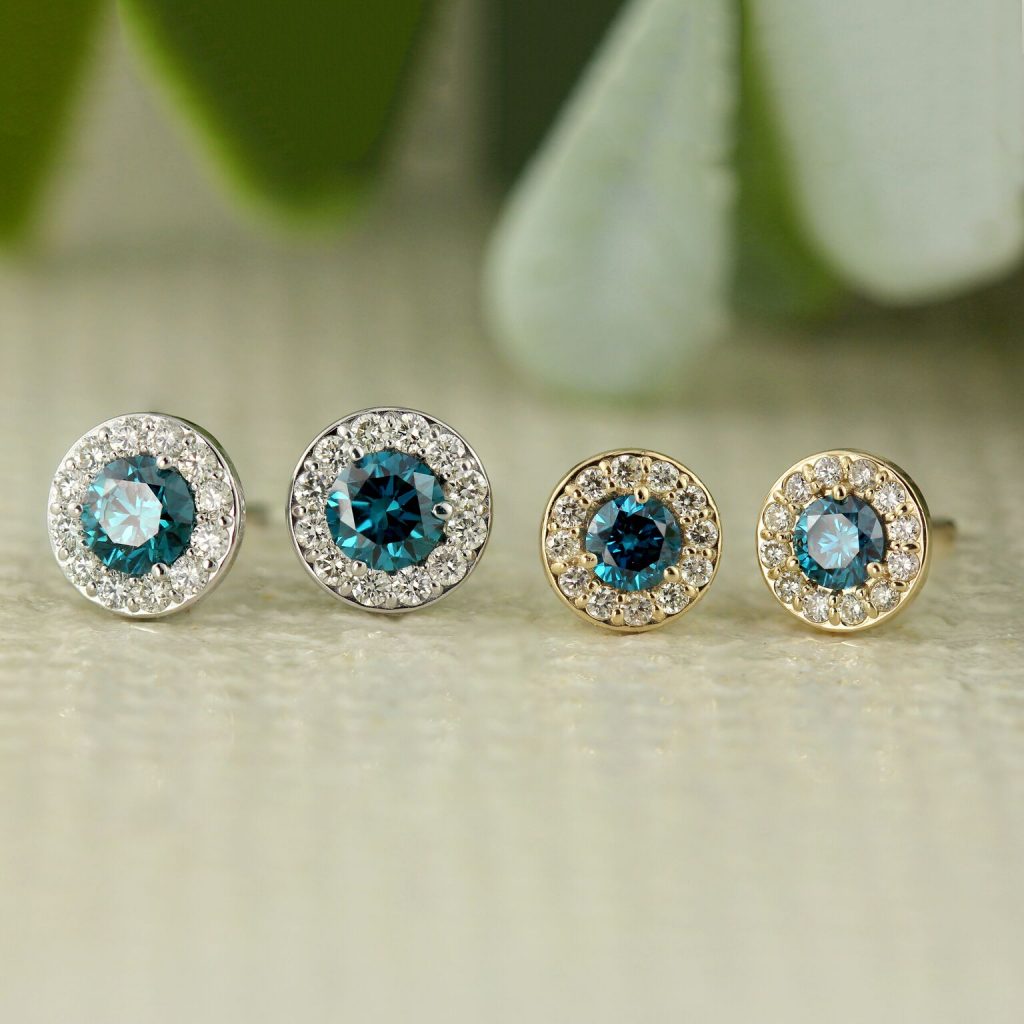
These blue diamond studs feature gorgeously glamorous halo settings.
Halo diamond stud settings are all about glamour and impact. Halo settings enclose your center stones within rings of smaller diamonds, which amp up the overall shimmer of your studs. Not only that, they also provide an optical illusion: they make your center stones look larger than they actually are. So if you’re looking for maximum sparkle and drama, the halo setting is your perfect fit.
A Dazzling Alternative Setting: The Dangle Setting
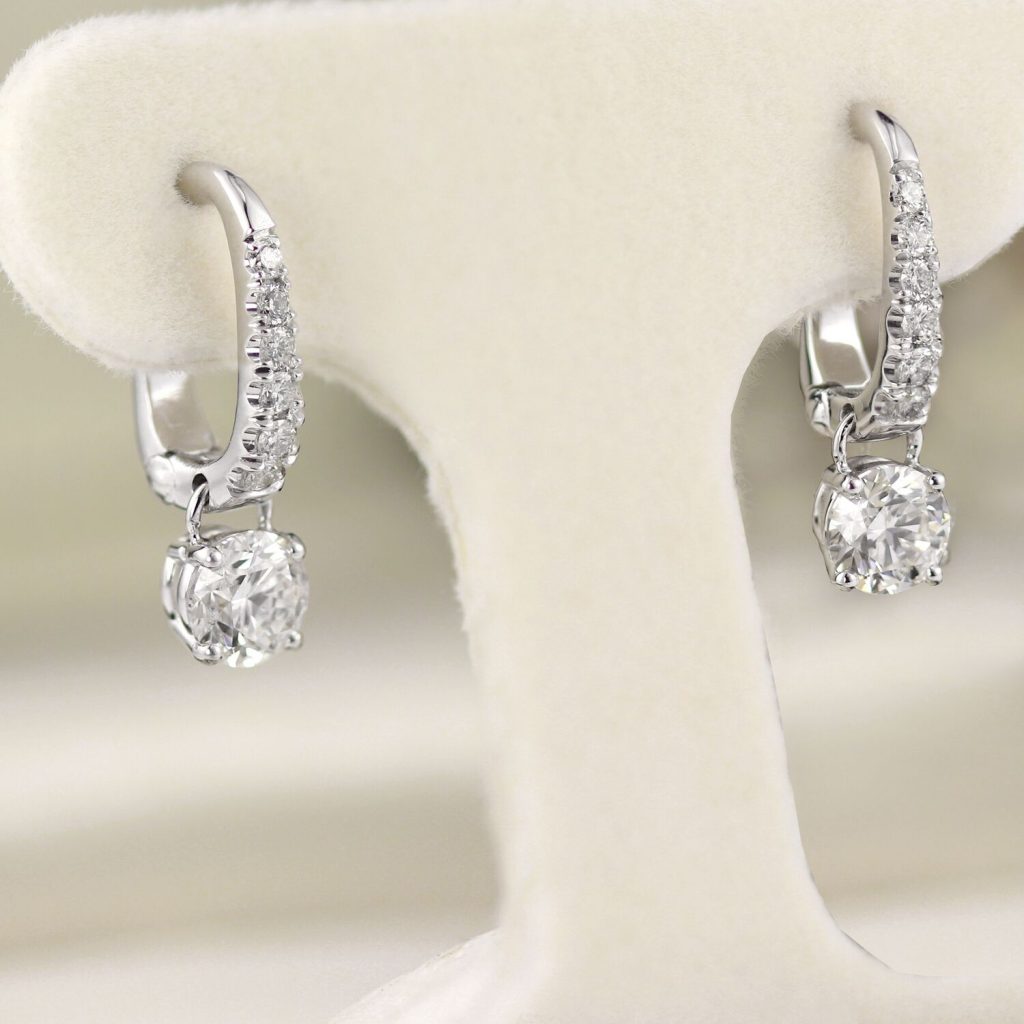
These round cut diamond earrings feature our sublimely elegant dangle settings.
At DiamondStuds.com, our customizable diamond stud builder allows you to opt for dangle settings for your pair of diamond stud earrings. With this setting style, your center diamonds rest in prong settings that dangle from a petite hoop closure. Dangle settings are a luxe and elegant option that can make your diamonds look even more dazzling, since they’ll catch the light with your every movement.
Haven’t decided on your ideal setting style? View our Diamond Earring Setting Education Guide to learn even more about your setting style options.
Step Two: Choosing Your Perfect Precious Metal
After you’ve picked out your setting style, it’s time to select your precious metal. Your choice of precious metal affects the style of your studs, as well as how flattering they may be when worn– for both you and your diamonds. Additionally, if you have any metal allergies, choosing your precious metal can also be a practical consideration. So, which precious metal is right for you? Below, see our notes on your four precious metal options: yellow gold, rose gold, white gold, and platinum.
Yellow Gold
Yellow gold is a classic, traditional precious metal that lends a golden glow to diamond jewelry. This precious metal has a warm tone, which means it’s often the most flattering on those with warm skin undertones.
White Gold
White gold is a chic, elegant precious metal that can make white diamonds look even icier. Since it’s coated in rhodium, white gold is also the most reflective of all precious metals, which can add to the bling factor of your jewelry. As it’s quite icy, white gold has cool tones, making it highly flattering on those with cool skin undertones.
Rose Gold
Rose gold is a unique, romantic choice that’s become rather trendy in recent years. This lovely precious metal has a warm to neutral tone, making it flattering for all skin undertones, but especially flattering on those with neutral skin undertones.
Platinum
Platinum is a luxe precious metal that looks quite similar to white gold, with its chic white hue and cool undertones. However, platinum has a couple of practical advantages over gold. First, platinum is a stronger precious metal that requires less upkeep than gold. And second, platinum is hypoallergenic. Platinum doesn’t contain any nickel, making it the best precious metal option for those with nickel allergies.
A Note on Precious Metals and Diamond Color Grading
White diamonds take in light, then reflect and refract it to create beautiful shimmer. However, white diamonds will also reflect some of the color of the settings they’re placed in. And it’s important to consider that when selecting a precious metal for diamond studs, a diamond engagement ring, or any diamond jewelry. Generally, we would say that if you opt for colorless diamonds, you may want to pair them with a white metal like white gold or platinum. This will ensure that your high quality diamonds look as white as possible. Then, if your diamonds have a hint of color to them, you may want to select a yellow gold or rose gold setting. These warmer precious metals tend to mask yellow tones in a diamond, making their color far less noticeable.
Step Three: Selecting Your Earring Backs
The last step in picking out your earring settings is deciding on your earring backs, which can affect your earrings’ security, ease of wear, and comfort.
Push Backs
Push backs are the most popular type of earring back. This style of earring back pushes into place, holding your studs securely on your ears through the use of friction. While push backs are fairly secure, they aren’t as secure as the other options will go over below. However, many people still prefer push backs for their diamond studs because they’re affordable, incredibly easy to use, and hard to see (making them a great option for those with smaller earlobes).
Screw Backs
Screw backs screw into place onto a threaded earring post, just like a nut would screw onto a threaded screw or bolt. This type of earring back is quite secure and also quite petite, making them an excellent, secure option for those with smaller earlobes. However, screw backs do take longer to put on, since they need to be carefully screwed on with each wear. They can also be challenging to put on for those with mobility issues. So while many people love the discreet security of a screw back, they may not be the best fit for those who want to put on their earrings quickly or for those who have trouble grasping small objects.
Secure Lock Backs
Secure lock backs are the most secure type of earring back. These earring backs slip onto your earring post, then securely lock into place through the use of a double groove secure locking mechanism. Secure lock backs are a wonderful option for those who want more peace of mind when they wear their diamond earrings. And they can also be a particularly good option for larger diamond or gemstone stud earrings, since this wider earring back can make wearing a heavier earring more comfortable. However, note that because this earring back is larger, it can sometimes be easier to see on those with smaller earlobes.
Want to learn even more about earring backs? See our recent post on What Backing Type to Select.
Final Thoughts on The Best Setting for Your Diamond Studs
There you have it: our in-depth guide to selecting the best setting for your diamond studs! Ready to select your perfect setting? Shop our customizable diamond stud earrings. Or, if you still have questions about picking out the best diamond stud earring setting for you, please feel free to reach out! Diamond studs are our speciality and we’re happy to answer any additional questions you may have about stud earring settings or diamond studs in general.







 1-855-969-7883
1-855-969-7883 info@diamondstuds.com
info@diamondstuds.com



